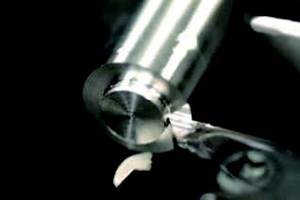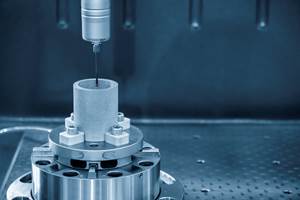Tune Chatter Out Of Tools
A basic tenet of metalcutting is shorter tools are more rigid than longer tools and generally deliver better cutting results. Closer proximity of a cutting edge to a machining center spindle or turning center turret translates into higher feeds and speeds with better surface finish and less chatter.
Share





A basic tenet of metalcutting is shorter tools are more rigid than longer tools and generally deliver better cutting results. Closer proximity of a cutting edge to a machining center spindle or turning center turret translates into higher feeds and speeds with better surface finish and less chatter. This proximity is expressed as the cutter length to diameter ratio.
For many of the metalcutting applications processed in shops, a reasonable cutter length to diameter ratio is easily achievable. And in cases where some chatter is induced, a change in speeds and feeds will generally eliminate it. But there are applications where it's necessary to "hang a cutter out there."
Examples include mold making and deep pocket milling for aerospace componenets where a cutter must be long enough to reach inside a cavity yet slender enough to allow the cutter to move about inside the pocket. In turning applications deep boring bars needed to bore through workpieces push the recommended length to diameter ratio envelope.
In these, and other applications like them, chatter becomes a process inhibitor. When an extended tool tip encounters a workpiece, the forces generated tend to make the cutter oscillate. It's like a tuning fork. Strike the end of the fork and it vibrates. The length and thickness of the tines determine vibration frequency.
However, touch the fork and it stops. If you hold the tuning fork by its tines and strike them, they won't vibrate. Chatter in an extended cutting tool is like the vibration of a tuning fork. A new device from Kennametal acts to, in effect, grab the forks so they won't vibrate. They are damped.
Called tuned tooling, the device consists of a sensor that is placed on a special toolholder, an instrumented hammer and an electronic analyzer. Tool tuning can be done on-line or off-line.
In operation, a sensor from the tuner unit is attached to the milling cutter or boring bar. Inside the tool shank is an adjustable internal damper. The damper is accessed by a setscrew. Before the tuning is done, the damper is compressed.
The operator taps the cutter end of the toolholder with an instrumented hammer, which is also attached to the tuner unit. The tool's dynamic response is monitored on the tuner unit and the operator is instructed to position the damper to counteract the vibration response. This sequence is repeated, as necessary, until the dynamic response is minimized. At that point the cutter is tuned. A setscrew locks the damper into position.
So, how does it cut? Test cuts at Kennametal have shown dramatic results. Increases in cutting speeds, feeds and depths of cut in steel and aluminum on turning and machining centers show the concept works.
For example, tuned and untuned boring bars were tested on a lathe. The tool was a 2-inch diameter bar with 12 inches of overhang, a 6-to-1 length-to-diameter ratio. Material was 1045 steel with a Brinnell of 200. Initial depth of cut with a standard boring bar was 0.015 inch at 400 sfm and 0.012 inch feed. As most machinists would recognize, a setup like this at those speeds, is going to vibrate. Chatter marks on the workpiece confirmed it. But when the same tool was tuned and then run at those speeds, no chatter was in evidence. Depth of cut was pushed up to 0.120 inch, still with no chatter.
Then the bar was increased to 20 inches of overhang, a 10-to-1 ratio. At 600 sfm and 0.015-inch depth-of-cut, no chatter, then 0.030-inch depth, still nothing. The test went to 0.090-inch depth-of-cut with no chatter and good surface finish.
On rotary tools the results were similar. To cut a workpiece of 6061 aluminum, an 18-inch long cutter was run at 2000 rpm with a cut depth of 0.145-inch, 1047 spm with a feed of 18 ipm. It chattered badly. The toolholder was then tuned and the same test cut run only the depth-of-cut was increased to 0.26 inch. A surface tester placed on the finished workpiece read 16 ra finish for this test piece.
Tuned tooling and the procedure used to tune the tools are not necessary on every application in a metalcutting shop. But for the jobs that require long tools, have chatter problems from interrupted cuts or variances in stock, or surface finish specs that are hard to hit, tuning the tool may allow the shop to solve the problem with an increase in productivity. It might be worth a look.
Related Content
Toolpath Improves Chip Management for Swiss-Type Lathes
This simple change to a Swiss-type turning machine’s toolpath can dramatically improve its ability to manage chips.
Read MoreOrthopedic Event Discusses Manufacturing Strategies
At the seminar, representatives from multiple companies discussed strategies for making orthopedic devices accurately and efficiently.
Read MoreParts and Programs: Setup for Success
Tips for program and work setups that can simplify adjustments and troubleshooting.
Read MoreShop Reclaims 10,000 Square Feet with Inventory Management System
Intech Athens’ inventory management system, which includes vertical lift modules from Kardex Remstar and tool management software from ZOLLER, has saved the company time, space and money.
Read MoreRead Next
AMRs Are Moving Into Manufacturing: 4 Considerations for Implementation
AMRs can provide a flexible, easy-to-use automation platform so long as manufacturers choose a suitable task and prepare their facilities.
Read MoreMachine Shop MBA
Making Chips and 91ÊÓƵÍøÕ¾ÎÛ are teaming up for a new podcast series called Machine Shop MBA—designed to help manufacturers measure their success against the industry’s best. Through the lens of the Top Shops benchmarking program, the series explores the KPIs that set high-performing shops apart, from machine utilization and first-pass yield to employee engagement and revenue per employee.
Read More




















